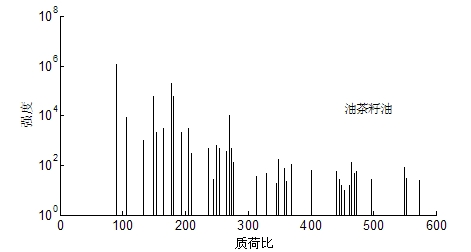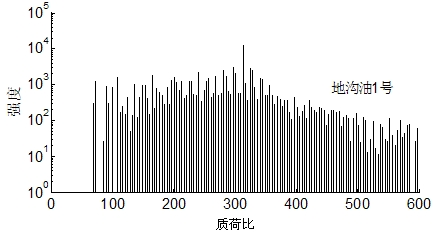Method for identifying drainage oil
An identification method and technology for waste oil, which are used in measuring devices, material analysis by electromagnetic means, instruments, etc., can solve the problems of low sensitivity, weak specificity, and inability to effectively and accurately identify waste oil, etc., and achieve fast and accurate identification. Identify and analyze fast effects
- Summary
- Abstract
- Description
- Claims
- Application Information
AI Technical Summary
Problems solved by technology
Method used
Image
Examples
Embodiment 1
[0028] The instruments used in the chemical ionization mass spectrometry analysis of the oil sample in this example include: DAPCI ion source developed by East China University of Technology, LTQ2XL enhanced linear ion trap mass spectrometer from Finnigan Company in the United States, and a data system equipped with Xcalibur; the reagents used are: Chromatographic pure methanol; the oil samples selected in the first step below include: Arowana rapeseed oil, Arowana soybean oil, Arowana peanut oil, Arowana blended oil, Arowana corn oil, Arowana sesame oil, Arowana sesame oil, Arowana sesame oil purchased from supermarkets Sunflower oil, Fulinmen blended oil, Fulinmen corn oil, Jintuotian camellia oil, Luhua sesame oil, Olivia olive oil and Shangrao camellia oil, a total of 13 edible oil samples; waste oil provided by Beijing industry and commerce department 1 No. 2, No. 3 waste oil, No. 3 waste oil, No. 4 waste oil, No. 5 waste oil, No. 6 waste oil, No. 7 waste oil, No. 8 waste ...
Embodiment 2
[0051] In this embodiment, the instrument used for the chemical ionization mass spectrometry analysis of the oil sample is the same as that in Embodiment 1. The reagents used are the same as in Example 1. The oil samples selected in the first step below include: Arowana rapeseed oil, Arowana soybean oil, Arowana peanut oil, Arowana blend oil, Arowana corn oil, Arowana sesame oil, Fulinmen sunflower oil, Fulinmen Blended Oil, Fulinmen Corn Oil, Jintuotian Camellia Seed Oil, Luhua Sesame Oil, Olivieran Olive Oil, a total of 12 kinds of edible oil samples; waste oil No. 1, waste oil No. 2, waste water provided by the Beijing Industrial and Commercial Department Oil No. 3, Waste Oil No. 4, Waste Oil No. 5, Waste Oil No. 6, Waste Oil No. 7, Waste Oil No. 8, Waste Oil No. 9, Waste Oil No. 10, Waste Oil No. 11, Waste Oil No. 12, Waste Oil No. 13 waste oil, No. 14 waste oil, No. 15 waste oil, No. 16 waste oil, No. 17 waste oil, No. 18 waste oil, No. 19 waste oil and No. 20 waste oil,...
Embodiment 3
[0071] In this embodiment, the instrument used for the chemical ionization mass spectrometry analysis of the oil sample is the same as that in Embodiment 1. The reagents used are the same as in Example 1. The oil samples selected in the first step below include: Arowana soybean oil, Arowana rapeseed oil, Arowana peanut oil, Arowana corn oil, Arowana sesame oil, Arowana blend oil, Fulinmen sunflower oil, Fulinmen Corn Oil, Fulinmen Blended Oil, Jintuotian Rapeseed Oil, Luhua Sesame Oil and Olivia Olive Oil, a total of 12 kinds of edible oil samples; waste oil samples that are identified as waste oil samples include : Waste oil No. 1, waste oil No. 2, waste oil No. 3, waste oil No. 4, waste oil No. 5, waste oil No. 6, waste oil No. 7, waste oil No. 8, waste oil 9 provided by the Beijing Industrial and Commercial Department No. 10, No. 11, No. 12, No. 13, No. 14, No. 15, No. 16, No. 17, No. 18, No. 19 No. 20 and No. 20 waste oil samples were identified as oil samples; expired F...
PUM
 Login to View More
Login to View More Abstract
Description
Claims
Application Information
 Login to View More
Login to View More - R&D
- Intellectual Property
- Life Sciences
- Materials
- Tech Scout
- Unparalleled Data Quality
- Higher Quality Content
- 60% Fewer Hallucinations
Browse by: Latest US Patents, China's latest patents, Technical Efficacy Thesaurus, Application Domain, Technology Topic, Popular Technical Reports.
© 2025 PatSnap. All rights reserved.Legal|Privacy policy|Modern Slavery Act Transparency Statement|Sitemap|About US| Contact US: help@patsnap.com



